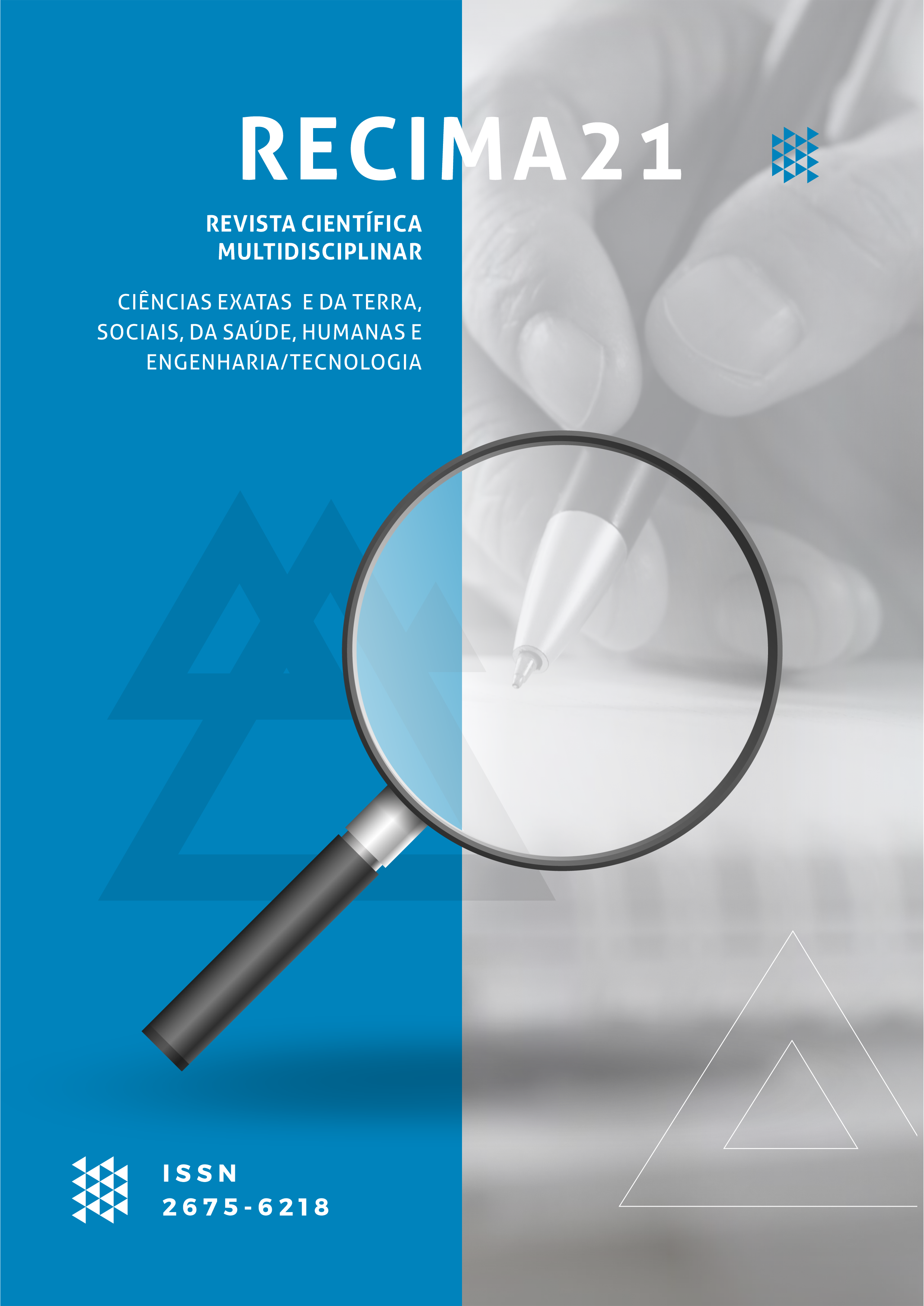LESÃO DE LIGAMENTO CRUZADO ANTERIOR EM ATLETAS DE FUTEBOL: UMA REVISÃO INTEGRATIVA
DOI:
https://doi.org/10.47820/recima21.v3i9.1906Palavras-chave:
Futebol, Lesão, CirurgiaResumo
Introdução: A ruptura do ligamento cruzado anterior (LCA) é uma das lesões mais prevalentes e graves nos esportes com bola, principalmente no futebol, ocorrendo principalmente em situações em que não há contato. Diante do exposto, há necessidade de um estudo que busque informar melhor sobre as cirurgias de lesão do ligamento cruzado anterior em atletas de futebol. Sendo assim, o objetivo do estudo se dá por expor assunto de forma sólida, reunindo artigos de qualidade e atuais disponíveis na literatura nacional e internacional. Materiais e métodos: Trata-se de uma revisão integrativa da literatura. Após aplicação de todos os critérios de inclusão e exclusão, obteve-se uma amostra final de 6 artigos para a revisão integrativa. Resultado e discussão: É dito que a incidência de lesões de LCA é maior em atletas do sexo feminino quando comparada ao sexo masculino. Em relação à frouxidão residual no enxerto de LCA, estudos observaram que, à longo prazo, esse problema pode piorar o prognóstico dos pacientes, aumentando a chance de revisões cirúrgicas. Quanto ao retorno dos atletas ao futebol, observou-se que os jogadores que retornam ao esporte têm um risco significativamente maior de sofrer nova lesão no joelho. Conclusão: os artigos analisados sugeriram que o tratamento cirúrgico foi altamente resolutivo no caso de lesões de LCA.
Downloads
Referências
Grassi A, Macchiarola L, Filippini M, Lucidi GA, Della Villa F, Zaffagnini S. Epidemiology of Anterior Cruciate Ligament Injury in Italian First Division Soccer Players. Sports Health. 2020 May/Jun;12(3):279-288. doi: 10.1177/1941738119885642. Epub 2019 Dec 4. PMID: 31800358; PMCID: PMC7222666.
García-Luna MA, Cortell-Tormo JM, García-Jaén M, Ortega-Navarro M, Tortosa-Martínez J. Acute Effects of ACL Injury-Prevention Warm-Up and Soccer-Specific Fatigue Protocol on Dynamic Knee Valgus in Youth Male Soccer Players. Int J Environ Res Public Health. 2020 Aug 4;17(15):5608. doi: 10.3390/ijerph17155608. PMID: 32759692; PMCID: PMC7432391.
Lima YL, Ferreira VMLM, de Paula Lima PO, Bezerra MA, de Oliveira RR, Almeida GPL. The association of ankle dorsiflexion and dynamic knee valgus: A systematic review and meta-analysis. Phys Ther Sport. 2018 Jan;29:61-69. doi: 10.1016/j.ptsp.2017.07.003. Epub 2017 Jul 19. PMID: 28974358.
Barber-Westin S.D., Noyes F.R. Effect of fatigue protocols on lower limb neuromuscular function and implications for anterior cruciate ligament injury prevention training: A systematic review. Am. J. Sports Med. 2017;45:3388–3396. doi: 10.1177/0363546517693846.
Waldén M, Hägglund M, Magnusson H, Ekstrand J. ACL injuries in men’s professional football: a 15-year prospective study on time trends and return-to-play rates reveals only 65% of players still play at the top level 3 years after ACL rupture. Br J Sports Med. 2016;50:744-750.
Souza, M. T. D., Silva, M. D. D., & Carvalho, R. D. (2010). Revisão integrativa: o que é e como fazer. Einstein (São Paulo), 8, 102-106.
Martin-Alguacil JL, Arroyo-Morales M, Martin-Gómez JL, Lozano-Lozano M, Galiano-Castillo N, Cantarero-Villanueva I. Comparison of knee sonography and pressure pain threshold after anterior cruciate ligament reconstruction with quadriceps tendon versus hamstring tendon autografts in soccer players. Acta Orthop Traumatol Turc. 2019;53(4):260-265. doi:10.1016/J.AOTT.2019.04.012
Sandon A, Engström B, Forssblad M. High Risk of Further Anterior Cruciate Ligament Injury in a 10-Year Follow-up Study of Anterior Cruciate Ligament-Reconstructed Soccer Players in the Swedish National Knee Ligament Registry. Arthroscopy. 2020;36(1):189-195. doi:10.1016/J.ARTHRO.2019.05.052
Lindanger L, Strand T, Mølster AO, Solheim E, Inderhaug E. Effect of Early Residual Laxity After Anterior Cruciate Ligament Reconstruction on Long-term Laxity, Graft Failure, Return to Sports, and Subjective Outcome at 25 Years. Am J Sports Med. 2021;49(5):1227-1235. doi:10.1177/0363546521990801
Alessio-Mazzola M, Formica M, Russo A, et al. Outcome after Combined Lateral Extra-articular Tenodesis and Anterior Cruciate Ligament Revision in Professional Soccer Players. J Knee Surg. 2019;32(9):906-910. doi:10.1055/S-0038-1672120
Sigward SM, Cesar GM, Havens KL. Predictors of Frontal Plane Knee Moments During Side-Step Cutting to 45 and 110 Degrees in Men and Women: Implications for Anterior Cruciate Ligament Injury. Clin J Sport Med. 2015;25(6):529-534. doi:10.1097/JSM.0000000000000155
Alentorn-Geli E, Seijas R, Martínez-De la Torre A, et al. Effects of autologous adipose-derived regenerative stem cells administered at the time of anterior cruciate ligament reconstruction on knee function and graft healing. J Orthop Surg (Hong Kong). 2019;27(3). doi:10.1177/2309499019867580
Hewett TE, Myer GD, Ford KR, et al. Biomechanical measures of neuromuscular control and valgus loading of the knee predict anterior cruciate ligament injury risk in female athletes: a prospective study. Am J Sports Med. 2005;33(4):492-501. doi:10.1177/0363546504269591
Kachgal S, Putnam AJ. Mesenchymal stem cells from adipose and bone marrow promote angiogenesis via distinct cytokine and protease expression mechanisms. Angiogenesis. 2011;14(1):47-59. doi:10.1007/S10456-010-9194-9
Rehman J, Traktuev D, Li J, et al. Secretion of angiogenic and antiapoptotic factors by human adipose stromal cells. Circulation. 2004;109(10):1292-1298. doi:10.1161/01.CIR.0000121425.42966.F1
Hong SJ, Traktuev DO, March KL. Therapeutic potential of adipose-derived stem cells in vascular growth and tissue repair. Curr Opin Organ Transplant. 2010;15(1):86-91. doi:10.1097/MOT.0B013E328334F074
Downloads
Publicado
Edição
Seção
Categorias
Licença
Copyright (c) 2022 RECIMA21 - Revista Científica Multidisciplinar - ISSN 2675-6218

Este trabalho está licenciado sob uma licença Creative Commons Attribution 4.0 International License.
Os direitos autorais dos artigos/resenhas/TCCs publicados pertecem à revista RECIMA21, e seguem o padrão Creative Commons (CC BY 4.0), permitindo a cópia ou reprodução, desde que cite a fonte e respeite os direitos dos autores e contenham menção aos mesmos nos créditos. Toda e qualquer obra publicada na revista, seu conteúdo é de responsabilidade dos autores, cabendo a RECIMA21 apenas ser o veículo de divulgação, seguindo os padrões nacionais e internacionais de publicação.













